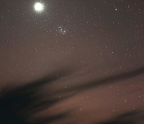The Unistellar eVscope

LET’S BE HONEST: To the untrained eye, most celestial objects look unimpressive through a typical backyard telescope. Sure, there are exceptions, such as the Moon, bright planets, the (safely filtered) Sun; the most colourful double stars; and about as many showpiece star clusters, nebulae and galaxies as you can count on your fingers and, if you’re generous, your toes. But most of the deep sky objects in celestial atlases and catalogues are not worth showing to our non-astronomer friends and neighbours, because the dim grey views through the eyepiece just can’t compare with the bright colourful Hubble images the public has become used to seeing.
Unistellar, a crowd-funded startup with offices in Marseille and San Francisco, has come up with a solution: the eVscope, or ‘enhanced vision’ telescope. Advertised as “100x more powerful than a regular telescope,” the eVscope — a mere 114-mm (4.5-inch) f/4 reflector — plainly shows the spiral arms of the Whirlpool Galaxy and the red glow of hydrogen gas and the dusty “pillars of creation” in the Eagle Nebula, even from a city.
The eVscope doesn’t violate any laws of physics. But when you look into its eyepiece in ‘eV’ mode, you’re not looking at the photons collected by the optics, as you would with an ordinary instrument. Those photons have been intercepted by a sensitive digital camera and converted to a display on a small colour screen — so you’re looking at a long-exposure image. I was skeptical that this would feel anything like looking through a ‘normal’ telescope. But when I
You’re reading a preview, subscribe to read more.
Start your free 30 days

